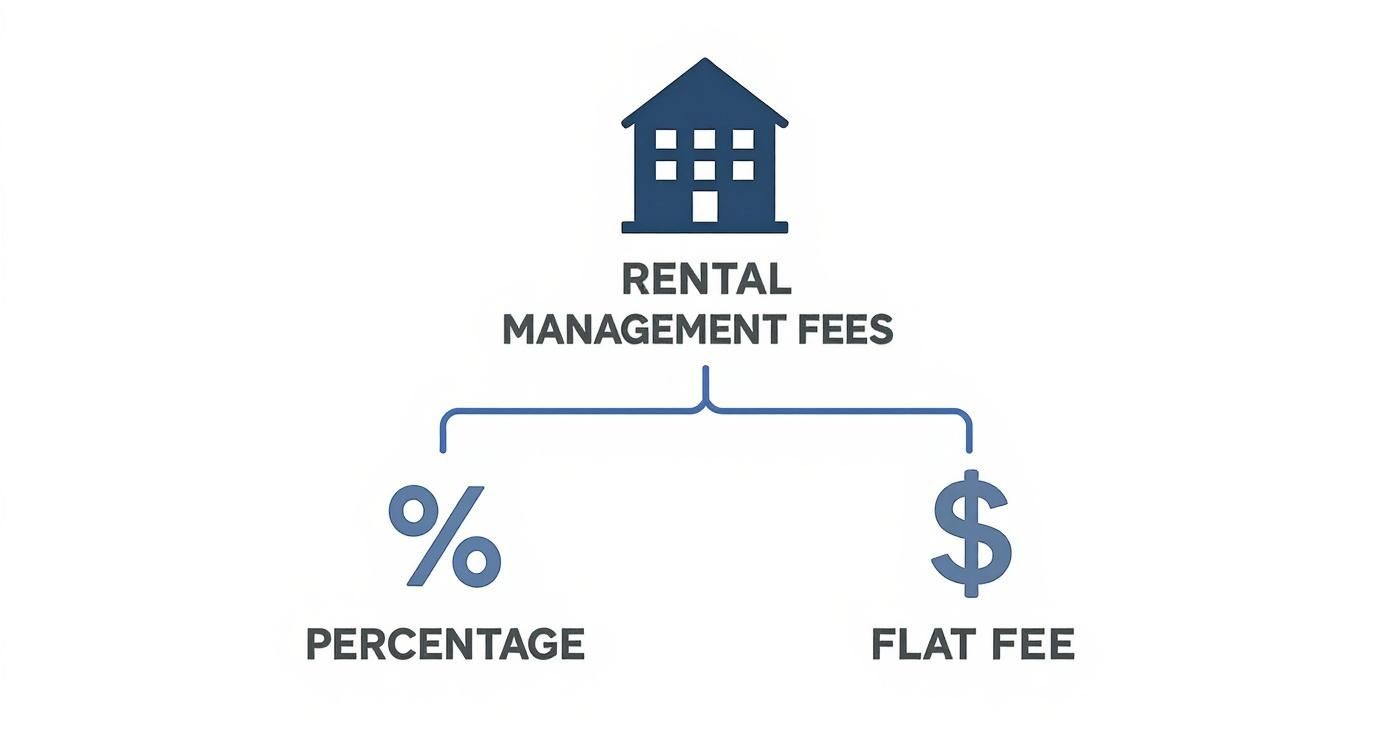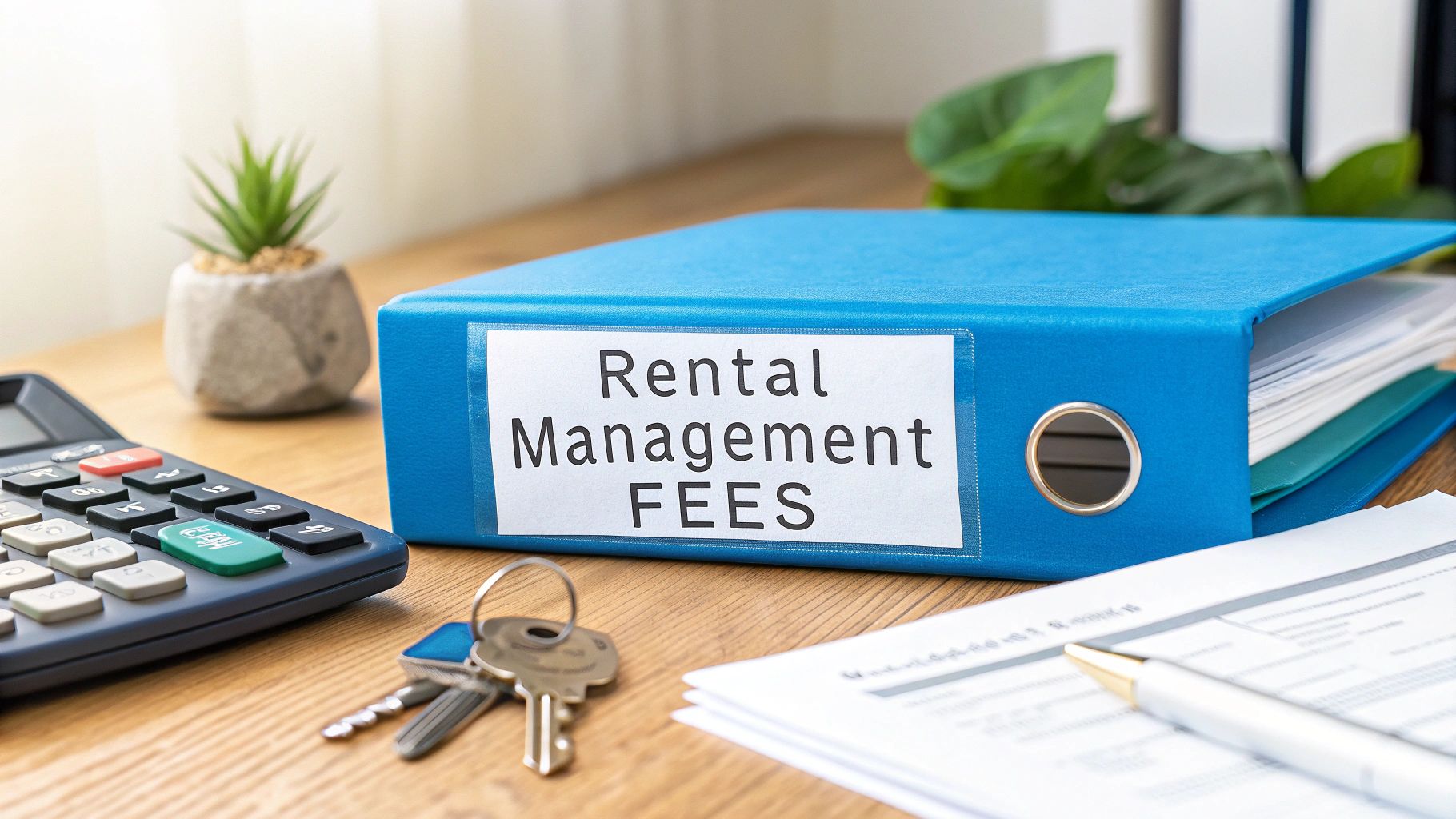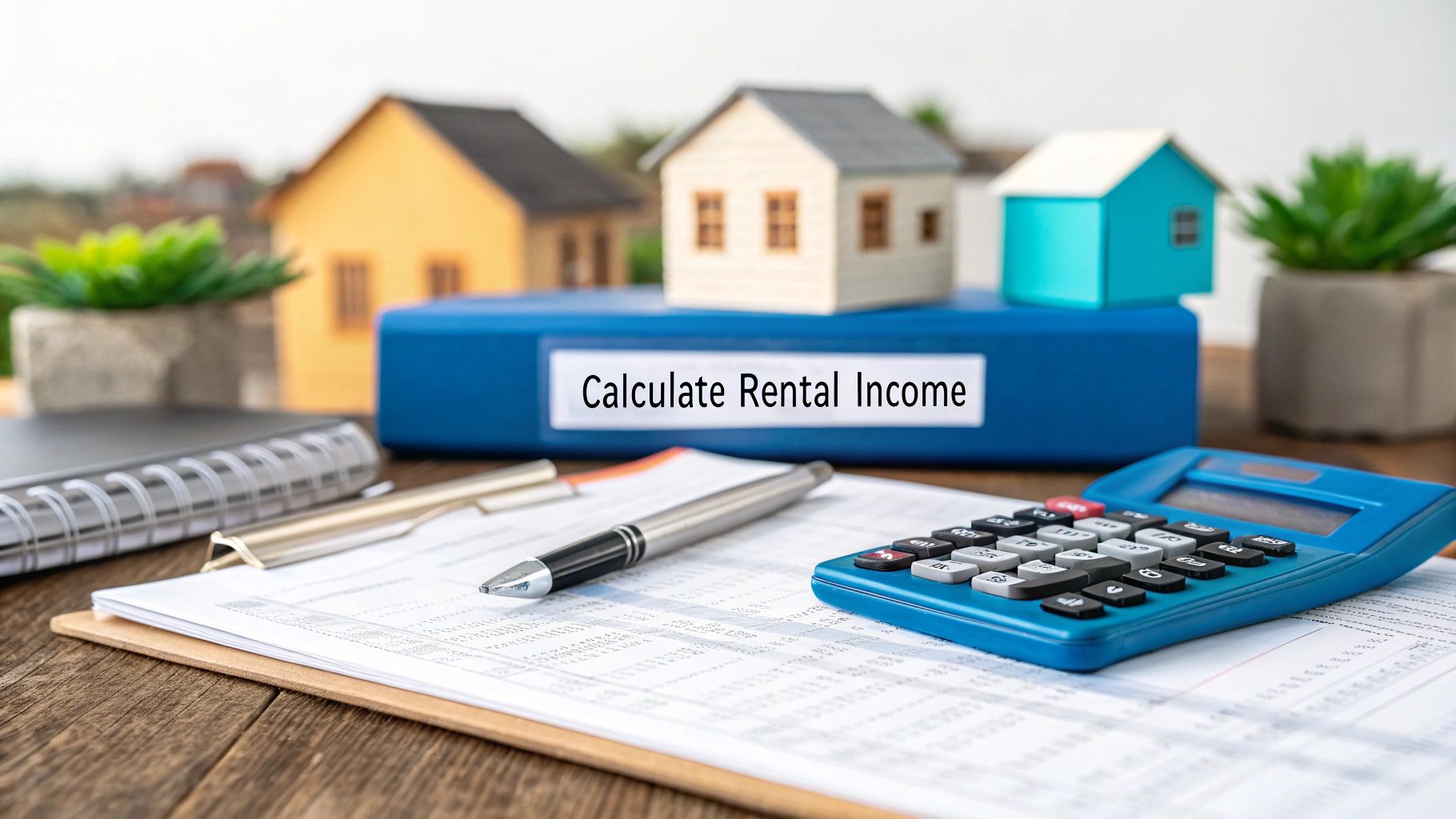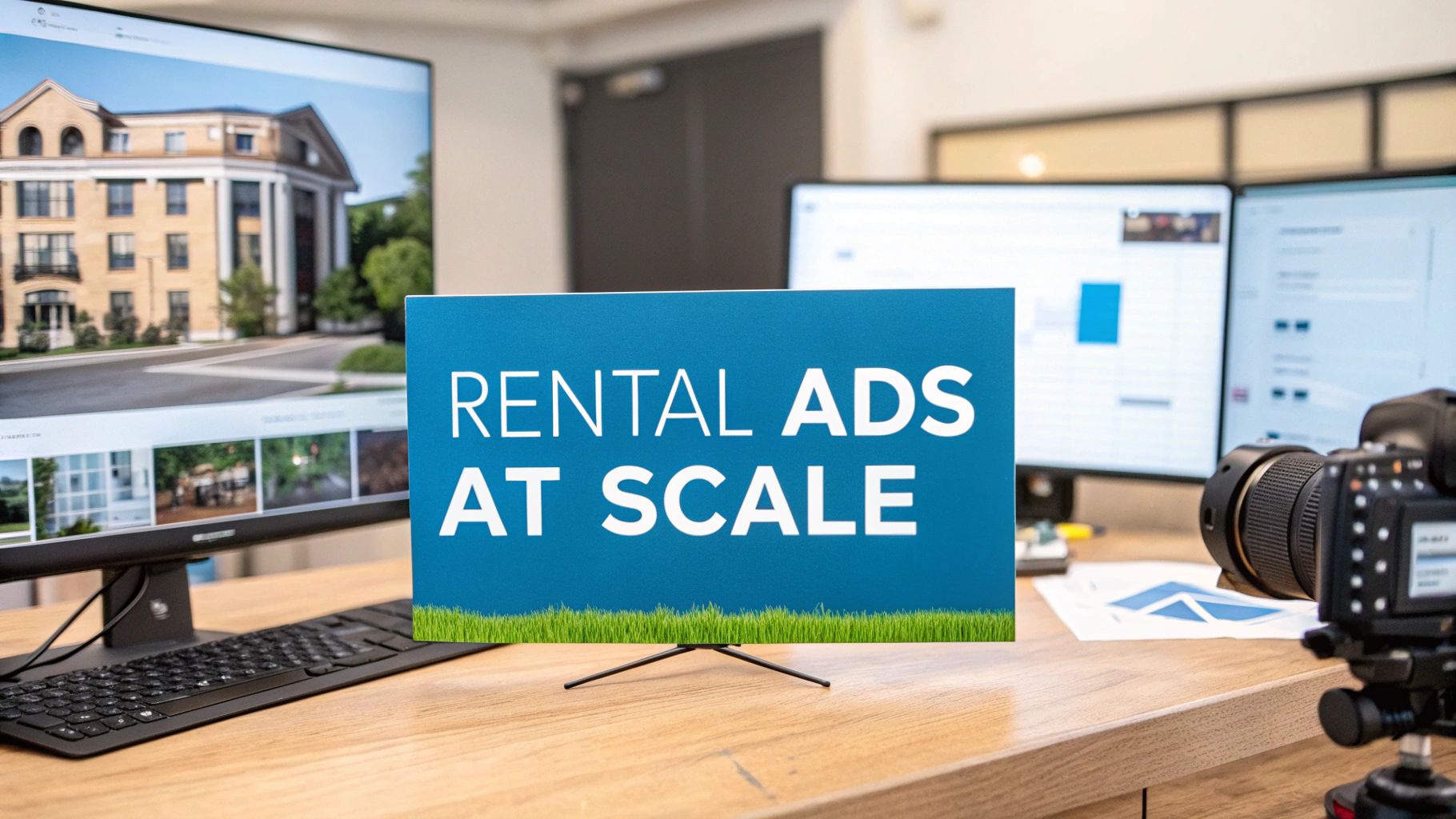When you're running a large rental portfolio, the management fee isn't just another line item on a spreadsheet—it's a critical lever for profitability and operational efficiency. While many property management companies charge between 8% to 12% of the monthly rent, large-scale operators know the real cost per door is far more nuanced.
For enterprise-level portfolios, understanding the fee structure is about more than just numbers. It’s about aligning with a partner whose operational model can reduce your Days on Market (DOM), boost lead-to-tour conversion, and ultimately, maximize revenue across hundreds or thousands of units.
Decoding Rental Management Fee Structures at Scale
For property managers overseeing extensive portfolios, the management fee is a strategic investment in operational excellence. It buys you standardized processes, tenant stability, and crucial revenue protection. The two primary models—percentage-based and flat-fee—have significant implications for your cost per door and overall portfolio performance.
Percentage-Based Management Fees
This is the most common model, where the management company takes a percentage of the collected rent from your occupied units. This structure inherently ties their success to yours: they don't get paid unless you do. This alignment is especially powerful for multi-market portfolios with a wide range of rent prices, as the fee naturally scales with revenue.
A 2024 analysis of the market shows the standard for residential fees remains 8% to 12% of collected rent. This typically covers core operations like tenant communication, rent collection, and maintenance coordination. In high-rent urban markets, the rate might dip to 6%, while properties requiring more intensive management can see fees closer to 15%.
The Revenue Impact of 1%: On a 1,000-unit portfolio with an average rent of $2,000, reducing your management fee from 9% to 8% adds $240,000 in annual NOI. This demonstrates why negotiation is critical when bringing significant scale to a potential partner.
Flat-Fee Management Structures
The alternative is a flat-fee structure, where you pay a fixed dollar amount per unit each month, regardless of the rent. This is often priced between $100 to $200 per door. The primary advantage is budget predictability, which simplifies financial forecasting across a large, distributed portfolio.
A flat fee can deliver significant savings for portfolios concentrated in high-rent areas. A fixed $150 fee is far more attractive than 8% of a $3,500 monthly rent. However, the critical task for operations directors is to ensure this predictable cost doesn't lead to reactive management. You must verify that the firm remains incentivized to proactively manage maintenance and tenant relations to protect your asset value.
While this structure is common for residential units, calculations differ for other asset classes. For context, detailed guides on commercial property management fees break down those distinctions.
To make it even clearer, here’s a quick side-by-side comparison of the two main fee structures. This should help you quickly see which model might be a better fit for your portfolio's financial and operational goals.
Comparing Standard Rental Management Fee Models
Ultimately, choosing between a percentage and a flat fee comes down to your portfolio's specific makeup. Analyze your average rent, market conditions, and what you value more—incentive alignment or cost predictability.
Uncovering the Full Spectrum of Management Fees
The monthly management fee is just the tip of the iceberg. To accurately calculate your true cost per door and forecast budgets, you must look beyond the base rate and dissect the ancillary costs that impact your bottom line. Ignoring them is a surefire way to encounter financial surprises that erode profitability, especially at scale.
For enterprise-level operators, scrutinizing the fine print isn't just a best practice—it's a financial necessity. This is where a deal that looks great on the surface can quickly become a costly partnership. Mastering these fee details is the first step to negotiating a contract that protects your revenue.
This infographic gives a great high-level overview of the two main fee models you'll encounter.

It really clarifies the basic difference between a variable percentage tied to rent and a predictable flat fee per door. Think of this as the foundation of any management agreement you sign.
Common Ancillary Charges to Scrutinize
Beyond the monthly fee, your management agreement will almost certainly include other charges. Each one impacts your net operating income, so you must factor them into your financial models.
- Tenant Placement or Leasing Fees: One of the most significant ancillary costs. Expect this to be 50% to 100% of the first month's rent. For a 1,000-unit portfolio with a 30% annual turnover rate, this fee becomes a massive operational expense line item.
- Lease Renewal Fees: When a tenant renews, some firms charge a fee to process the paperwork, often a flat rate of $200 to $300. While small per unit, this adds up quickly when renewing hundreds of leases annually.
- Maintenance Markups: It’s standard practice for companies to add a markup of 10% to 20% on vendor invoices for repairs. You must clarify this percentage and ensure it applies only to the direct cost of work, not the entire invoice.
- Eviction Processing Fees: In the event of an eviction, you’ll pay a coordination fee of $300 to $600, before legal costs are even factored in.
These fees stack up quickly. In major U.S. markets, the total annual cost of property management often lands between $2,000 to $3,000 per unit. This figure includes the base fee plus extras like account setup, inspections, vacancy coverage, and eviction processing, which can run from $600 to $1,200 per incident.
Understanding this full cost spectrum is essential. As you evaluate these numbers, consider how technology-driven service models can mitigate them. For instance, on-demand showing solutions can directly impact your leasing costs, as reflected in flexible models like Showdigs pricing, by reducing the time and overhead spent on leasing.
Why Management Fees Are Not One-Size-Fits-All
If you've ever requested quotes to manage a 500-unit portfolio, you know the numbers can be all over the map. That’s not random—it’s a direct reflection of the real-world operational costs of managing different assets at scale.
Getting a handle on these variables is the key to negotiating a fee that actually makes sense for the value you're getting. Let’s break down what really drives the cost per door so you can look past the percentages on a proposal and find a partner who fits your business.
It Starts with Property Type and Distribution
The single biggest factor in your management fee? The makeup of your portfolio. Managing a scattered portfolio of single-family homes is a completely different operational challenge than overseeing a large, centralized apartment building, and the pricing reflects that.
- Single-Family Rentals (SFRs): These geographically dispersed properties mean more drive time and logistical complexity for showings, inspections, and maintenance. This inherent inefficiency is why SFR management fees almost always land in the higher 8% to 12% range. The cost to service each door is fundamentally higher.
- Multi-Family Properties: Conversely, a 200-unit complex is a model of efficiency. A leasing agent can conduct a dozen tours without leaving the property, and maintenance can address multiple work orders in one trip. This operational density is why multi-family fees are often lower, typically between 4% and 8%.
If you're running a mixed portfolio, your final quote will be a blended rate based on your specific unit composition.
Location, Location, Location (and Market Dynamics)
Just like rent prices, management fees are hyperlocal. A company with an office in downtown Chicago or San Francisco is paying a premium for everything—from their own lease to their staff's salaries—compared to a firm in a smaller town.
Those higher operational costs naturally get passed on. Plus, a manager in a fiercely competitive rental market might charge more simply because their local expertise is worth more. They know the nuances of local laws, have connections with the best vendors, and can fill vacancies faster, all of which justifies a higher fee.
Scope of Services and the Power of Scale
Finally, what you're asking them to do and the size of your portfolio are huge negotiating levers. A bare-bones agreement for rent collection and emergency maintenance will obviously cost less than a full-service package that includes marketing, in-depth financial reporting, and managing capital improvement projects.
This is where your scale becomes your greatest asset. An operator with 1,000+ units is in a powerful position to negotiate tiered pricing. Many management companies will offer a reduced percentage as your portfolio grows, recognizing the efficiency gains of a larger, long-term partnership.
Once you understand how property type, location, and services affect pricing, you can stop asking, "How much do you charge?" and start asking the right questions to build a partnership that actually drives your bottom line.
Calculating the Real ROI of Your Management Partner
Focusing only on the lowest management fee is one of the most common—and costly—mistakes growing portfolios make. When you're comparing potential partners, the conversation has to shift from "how much do rental management companies charge" to "what is the return on that investment?"
The right partner isn't a line item on your expense sheet; they're a revenue driver. Think of their fee as an investment in operational performance. The true value comes from their direct impact on the metrics that matter most: minimizing vacancy loss, slashing Days on Market (DOM), and boosting your lead-to-tour conversion rates.

From Cost Per Door to Revenue Per Door
To get a clear picture of the real ROI, you need to connect a management company’s performance directly to your portfolio's bottom line.
Let's walk through a quick scenario. Imagine you have a 1,000-unit portfolio with an average monthly rent of $2,000. You're comparing two potential management partners:
- Company A: Charges a 7% management fee.
- Company B: Charges a slightly higher 8% fee, but their tech-forward leasing process cuts the average DOM by 5 days.
At first glance, Company A seems like a no-brainer. But let’s calculate the revenue impact of that vacancy reduction.
A 5-day reduction in vacancy across a 1,000-unit portfolio with 30% annual turnover (300 units) and a daily rent of $66.67 ($2,000 / 30 days) translates to $99,990 in recovered revenue (300 units x 5 days x $66.67/day).
Suddenly, that extra 1% fee for Company B doesn't just pay for itself—it generates a massive net gain. This is the heart of ROI-driven decision-making. For large portfolios, every day a unit sits empty is a significant, quantifiable loss.
For property managers looking to squeeze every bit of profit from their assets, there are tons of strategies for boosting your portfolio's ROI that go hand-in-hand with a great management partner.
Quantifying the Value of Speed and Efficiency
The ROI calculation goes way beyond just DOM. A top-tier management partner shines in other key areas that directly pad your bottom line. It’s helpful to understand the key differences between professional and DIY property care—a concept that applies just as much to management as it does to maintenance.
Don’t be afraid to ask for hard data on their performance metrics:
- Lead-to-Tour Conversion Rate: What percentage of inquiries result in a showing? A higher conversion rate means a larger pool of qualified applicants, leading to faster leasing.
- Application-to-Lease Ratio: How efficiently do they convert submitted applications into signed leases? Streamlining this process is crucial for minimizing vacancy.
- Tenant Retention Rate: A partner who excels at tenant satisfaction can drastically reduce turnover costs, a major drain on profitability.
By prioritizing these performance indicators over a simple fee percentage, you choose a partner that actively contributes to your net operating income. You’re not just hiring a manager; you’re investing in a system that delivers measurable returns at scale.
How Technology Shapes Management Costs and Value
In today's rental market, a property management company's tech stack is the engine that drives their efficiency and your portfolio’s profitability. The sophistication of their tools directly impacts their fee structure and the value they deliver. The question "how much do rental management companies charge?" is now inseparable from the technology they leverage.
A management company that invests in automating leasing, maintenance, and accounting workflows builds a formidable operational advantage. Systematized internal processes reduce their costs, and for large-scale operators, these savings often translate into more competitive pricing.
From Manual Tasks to Automated Revenue
The real power of technology isn't just about saving the management company money; it's about generating more revenue for you. Tech-forward services are essential tools for maximizing income, especially across a distributed portfolio.
Consider the technology that directly grows your bottom line:
- Automated Lead Follow-Up: Instant responses to every inquiry prevent hot leads from going cold, dramatically boosting lead-to-tour conversion rates.
- On-Demand & Self-Service Showings: Empowering prospective tenants to tour properties on their schedule—including evenings and weekends—is a game-changer for accelerating the leasing cycle.
- Centralized Communication Hubs: Using an integrated platform for tenant messages and maintenance requests ensures standardization and improves resident satisfaction.
For anyone managing properties in multiple markets, a partner with a scalable tech stack is the secret weapon for standardizing processes and achieving profitable growth. It’s how you guarantee a consistent, top-notch experience for every lead and resident, no matter where the property is located.
This automation is critical for reducing your Days on Market (DOM). An AI leasing assistant, for example, can pre-qualify leads and schedule tours 24/7, transforming a manual process that once took days into an automated one that takes minutes.
To see this in action, you can learn more about the benefits of using an AI leasing assistant and how it directly accelerates the entire leasing funnel. When vetting a management company, their investment in this type of technology is a direct signal of their ability to fill your vacancies faster.
Negotiating a Fee Structure for a Large Portfolio
When you're managing a portfolio of 100 to 10,000+ units, the management agreement is a strategic financial tool that directly shapes your cost per door, unit economics, and net operating income.
Your single greatest negotiating asset is scale.
Bringing hundreds or thousands of units to the table fundamentally changes the manager's operational calculus. You offer them economies of scale in everything from administrative overhead to marketing spend. That value must be reflected in your fee structure. This is where you move beyond standard pricing and build a true performance-based partnership.

Leveraging Volume for Tiered Pricing
For large portfolios, the most effective strategy is to negotiate a tiered pricing model. As your unit count grows, your management fee percentage shrinks. This creates a win-win scenario where the management company secures a significant, stable revenue stream, and you are rewarded for your scale.
A typical tiered structure might look like this:
- 1-250 Units: 8% management fee
- 251-750 Units: 7% management fee
- 751+ Units: 6% management fee
This approach does more than save money; it aligns your partner’s success with your own expansion goals. As you acquire more properties, your operational costs per door should fall, and your management fee should follow suit.
Structuring a Performance-Based Agreement
Astute operators don't stop at a simple tiered model. They build agreements that incentivize the metrics that drive their bottom line. This means tying a portion of management compensation to key performance indicators (KPIs) that directly impact revenue.
Consider building in performance bonuses or fee reductions based on:
- Days on Market (DOM): Offer a bonus for maintaining the portfolio's average DOM below a key threshold, such as 14 days.
- Tenant Retention: Reward the management company for achieving a renewal rate above a target, for example, 75%.
- Occupancy Rates: Structure fees to increase when portfolio-wide occupancy remains above 97% for a sustained period.
The global property management market is expected to reach $28 billion in 2025, with the U.S. market alone projected to hit $98.88 billion by 2029. In this environment, larger firms often command higher fees—sometimes 10% to 14%—but for large portfolios, these fees are almost always negotiable. You can explore more data by reviewing recent property management statistics.
By focusing negotiations on performance, you transform your management partner from a service provider into a key player in your revenue strategy. You're not just paying them to manage properties; you're incentivizing them to optimize assets and maximize your portfolio's financial performance.
Frequently Asked Questions
Are Property Management Fees Negotiable?
Absolutely. Fees are almost always negotiable, especially when you bring a large or growing portfolio to the table. Your scale is your most powerful negotiating tool—use it to secure a fee structure that reflects the value you offer as a client. Many companies are open to tiered pricing or volume discounts, where your fee percentage decreases as you add more units under their management.
Does the Monthly Fee Cover Tenant Placement?
Typically, no. The monthly management fee covers the ongoing operational oversight of an occupied property. The process of marketing a vacancy, showing the unit, screening applicants, and signing a new lease is a separate service covered by a one-time "leasing fee" or "tenant placement fee." This fee commonly ranges from 50% to 100% of the first month's rent and is a critical line item to include in your operational expense forecasts.
What Is a Fair Maintenance Markup?
A standard and fair markup on maintenance work typically falls between 10% and 20% of the vendor's direct cost. This fee compensates the management company for coordinating repairs, vetting contractors, and ensuring quality control. Before signing an agreement, get this percentage in writing and clarify exactly how it is calculated. Transparency here is key to preventing unforeseen costs from eroding your net operating income.
Ready to slash your Days on Market and see your lead-to-tour conversion rates climb? Showdigs offers the first AI-backed leasing automation platform built to scale right alongside your portfolio.
Learn how Showdigs can optimize your leasing operations today.






